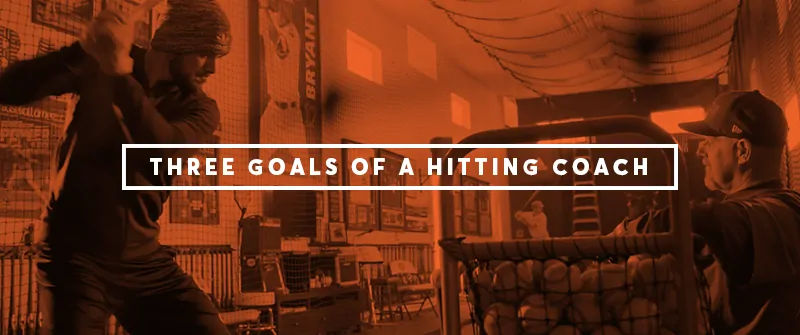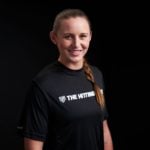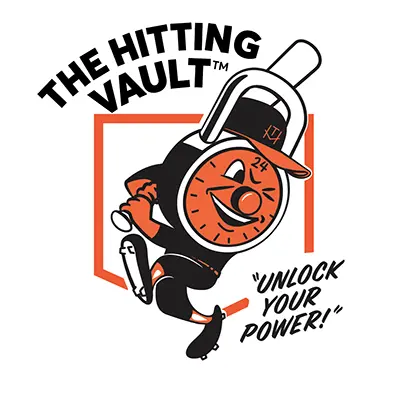Three Goals for Hitting Coaches

Table of Contents
It’s not always clear what the role of a hitting coach is. Should a hitting coach strive to give as much information as possible in the time they have, or is it important to internalize the concept of “less is more?” Can we best serve our hitters by teaching them the same exact swing as a pro hitter, or should we aim to help them understand what “good movements” are and then give them the freedom to find what works for them?
Ready to develop real power in your hitters?
Coach Lisle has a simple hitting plan for you. Learn from over 100+ exclusive videos for members and step-by-step instruction so you’ll know exactly how to help your hitters reach their potential. Over 970k people follow Coach Lisle and The Hitting Vault. Find out why.
At The Hitting Vault, we strive to help hitting coaches answer these questions so they can have the maximum positive impact. Recently, we wrote about Coach Lisle’s view on the role of a hitting coach and discussed a scientifically proven way to communicate more effectively with your athletes.
In this article, we’re going to outline three key goals you should strive for to help your hitters tap into their full potential.
Goal #1 — Speak Less and Do More
Ever heard of paralysis by analysis? It’s something that plagues many hitters and can stunt a hitter’s progress for months at a time. While it’s certainly important to help a hitter understand how the swing works on a mechanical level, that information has to be given and absorbed over time and in bite-sized pieces.
At your next hitting lesson or practice, pay attention to how much you’re talking. Are you the type of coach that’s overloading your hitters with info, cues or corrections? It’s understandable that you want to help your hitters as much as possible, but giving them too much information can cause them to overthink and become tentative, even in full swings.
Constantly nitpicking at every detail will:
- Be hard for them to follow, causing frustration.
- Make it difficult to prioritize and focus on adjustments.
- Cause persistent overanalysis that bleeds into games.
So, how do you speak less and do more?
Have a point of focus. If a player is working on maintaining torso tilt throughout their swing, don’t switch halfway through a drill intended to help with that problem and tell them their hands are dropping. Keep the focus on the torso tilt. You can of course switch focuses during a session, but it’s important to make sure you avoid bouncing back and forth every swing.
Let the hitter explore the movement. Lots of players — especially younger ones — will seek their coach’s affirmation when learning new skills by constantly stopping and asking questions such as “like that?” and “is that right?” If it’s their first time learning the movement, chances are they’re not doing it right. But that doesn’t mean you need to answer their questions candidly.
Learning new movements takes reps, so there’s no point in feeding into this feedback loop — it won’t help them to hear you say “yes” or “no.” Instead, say something like, “just keep trying and feeling it out.” You can make small adjustments here and there, but if your drill design is good they’ll be learning by doing.
Bite your tongue. Players aren’t going to be perfect, so don’t make them feel like they have to be. Instead, demonstrate, show video examples, and focus on doing productive drills.
Goal #2 — Trick Them With Drills
Coach Lisle sometimes talks about how hitting coaches can use drills to “trick” their hitters. Keep in mind this doesn’t actually mean you’re deceiving them. It’s important to build trust with your hitters so they feel comfortable with you. But the idea of “tricking” your hitters can be an extremely powerful concept, and it ties in with Goal #1 (speaking less and doing more).
Simply, tricking them with drills means that you can teach movements and skills by using drills and cues that guide hitters into the proper positions. This tends to have a more positive outcome than using too much hitting verbiage — which is not very effective, as we discussed in our post on the difference between internal and external focus.
Instead of telling them what to do, you’re putting them through drills that build good habits by default, without the player having to consciously think about what they’re doing or why.
For example, if you have a hitter that’s struggling with their bat path, you can try to describe the problem and explain how to make adjustments. But if after some explaining they aren’t getting it, rather than beat a dead horse, you can simply give them drills that specifically target their bat path.
In some cases, that might be a better approach to begin with. If you’re coaching a young hitter or someone who doesn’t have a sophisticated understanding of the swing sequence, they’ll probably learn better by actually feeling the proper movement than by having you describe it.
We have a number of drills in The Hitting Vault, like the See Saw to Contact drill and the Get on Plane drill, that will help improve bat path without the hitter even realizing that’s what we’re working on.
The key to tricking them with drills is to use drills that help them feel their body movements and which produce good-quality reps. A lot of the drills out there are essentially pointless and don’t correlate to the good movements we want in the swing.
Goal #3 — Teach Good Movements
There are a lot of people out there who still think we should teach hitters different mechanics based on their age. There are two interpretations of what that means: teach movements that will have to be changed later if the hitter wants to improve, or teach movements that are essentially the same, but a bit less “big.”
The former includes terms like “squish the bug” and “hands to the ball.” Terms like those create movements that are objectively inefficient, and when ingrained into muscle memory over the course of thousands of reps they’ll be bad habits that are hard to break.
Why not teach the same movements that elite hitters do, so that players won’t have to unlearn something later?
Just think: if a hitter spends ages 5 through 12 squishing the bug because that’s an “age appropriate” movement, how many reps will they have taken to build that muscle memory? 5,000? 10,000? And how many swings will it take to unlearn that movement and retrain the body to properly release the back foot?
With that said, teaching a 6-year-old to load like Josh Donaldson or Javy Baez — hitters with good, but exaggerated movements — is not the best idea. There will be kids who can progressively learn those big movements, but the majority will struggle to control them, which will hinder their development.
What “Age Appropriate Movements” Means
Essentially, effective load and stride movements should be developed over the course of time, but the movements in the middle part of the swing can be taught from a young age. Young players won’t master these movements, because it takes years to perfect anything. But they also won’t be set back by having to unlearn bad mechanics.
Here’s an example: having a hitter start with their feet in a more neutral position, with their feet wider than their hips, allows them to take a small stride (maybe two or three inches), picking up their foot just a couple of inches off the ground. This helps keep the whole load and stride phase simple, while still teaching efficient and mechanically-sound movements.
As that hitter gets older and gains more body control and athleticism, he or she can shift to starting a little bit narrower if they’d like (therefore striding further), have a higher leg kick, and introduce more movement in the upper-half load.
The key here is that the swing itself is not changing — only the scale of the load and stride is changing. You want to build a foundation with the sequence of movements after launch position (hips, torso, then hands and barrel.) By teaching the correct sequence and movements, you will be building a foundation upon which the hitter can grow, instead of one that they have to tear down and reconstruct from scratch.
Hitting Coach Goals: Resources and Extra Reading
Here are a few articles that offer valuable insight into how elite hitting coaches interact with their players and programs.
- This article by Baseball America gives insight into the negatives that can come from hitting instruction. There are many hitting coaches out there that don’t have a full understanding of what it looks like to balance the use of data, analytics, cues and productive drills, without forgetting the importance of pitch selection, rhythm and timing. As hitting coaches, you can’t forget about these crucial aspects of the art of hitting.
- The Washington Nationals fired hitting coach Rick Eckstein in 2013, and brought on Rick Schu (who was there for three years, from 2013 to 2016). This article dives into the concept of whether making a hitting coach change is the best way to keep a program improving. The main difference the Nats’ GM identified between Eckstein and Schu was that the latter spent more time on approach. It’s a good illustration of how sometimes hearing the same mechanical philosophy, but in a different way, from a different perspective or with a different focal point, can have a positive effect.
- James Rowson (then with the Twins, now with the Marlins) was interviewed this past May to give insight on his coaching philosophy. He goes into how his players approach each at bat, and how, as a hitting coach, it’s important to have an individualized approach to every hitter (including knowing their swing inside and out).



